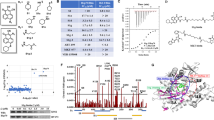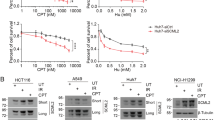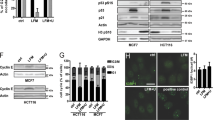Abstract
Checkpoint protein Chk1 has been identified as an Hsp90 client. Treatment with 100 nM geldanamycin (GM) for 24 h markedly reduced the Chk1 amount in Jurkat and ML-1 leukemia cell lines. Because Chk1 plays a central role in G2 checkpoint, we added GM to G2-arrested Jurkat and HL-60 cells pretreated with 50 nM doxorubicin for 24 h. GM slowly released both cell lines from doxorubicin-induced G2 arrest into G1 phase. GM also abrogated ICRF-193-induced decatenation G2 checkpoint in Jurkat and HL-60 cells. Western blot analysis showed that addition of GM attenuates doxorubicin- and ICRF-193-induced Chk1 phosphorylation at Ser345. GM, however, failed to abrogate G2 arrest in p53-positive ML-1 cells maybe due to the p21 induction. GM released HeLa cells from doxorubicin-induced G2 arrest but trapped them at M phase. Flow cytometric analysis showed that addition of GM converted doxorubicin-induced necrosis into apoptosis in Jurkat cells. Colony assay indicated that although GM has a weak cytotoxic effect as a single agent, it dramatically intensifies the cytotoxicity of doxorubicin and ICRF-193 in Jurkat and HL-60 cells. These results suggest that abrogation of G2 checkpoint by GM may play a central role in sensitizing p53-negative tumor cells to DNA-damaging and decatenation-inhibiting agents.
This is a preview of subscription content, access via your institution
Access options
Subscribe to this journal
Receive 50 print issues and online access
$259.00 per year
only $5.18 per issue
Buy this article
- Purchase on Springer Link
- Instant access to full article PDF
Prices may be subject to local taxes which are calculated during checkout






Similar content being viewed by others
References
Aligue R, Akhavan-Niak H, Russell P . (1994). A role for Hsp90 in cell cycle control: Wee1 tyrosine kinase activity requires interaction with Hsp90. EMBO J 13: 6099–6106.
Arlander SJH, Eapen AK, Vroman BT, McDonald RJ, Toft DO, Karnitz LM . (2003). Hsp90 inhibition depletes Chk1 and sensitizes tumor cells to replication stress. J Biol Chem 278: 52572–52577.
Bisht KS, Bradbury CM, Mattson D, Kaushal A, Sowers A, Markovina S et al. (2003). Geldanamycin and 17-allylamino-17-demethoxygeldanamycin potentiate the in vitro and in vivo radiation response of cervical tumor cells via the heat shock protein 90-mediated intracellular signaling and cytotoxicity. Cancer Res 63: 8984–8995.
Broemer M, Krappmann D, Scheidereit C . (2004). Requirement of Hsp90 activity for IκB kinase (IKK) biosynthesis and for constitutive and inducible IKK and NF-kB activation. Oncogene 23: 5378–5386.
Bulavin DV, Higashimoto Y, Demidenko ZN, Meek S, Graves P, Phillips C et al. (2003). Dual phosphorylation controls Cdc25 phosphatases and mitotic entry. Nat Cell Biol 5: 545–551.
Bull EEA, Dote H, Brady KJ, Burgan WE, Carter DJ, Cerra MA et al. (2004). Enhanced tumor cell radiosensitivity and abrogation of G2 and S phase arrest by the Hsp90 inhibitor 17-(dimethylaminoethylamino)-17-demethoxygeldanamycin. Clin Cancer Res 10: 8077–8084.
Bunz F, Dutriaux A, Lengauer C, Waldman T, Zhou S, Brown JP et al. (1998). Requirement for p53 and p21 to sustain G2 arrest after DNA damage. Science 282: 1497–1501.
Chen Q, Takeyama N, Brady G, Watson AJM, Dive C . (1998). Blood cells with reduced mitochondrial membrane potential and cytosolic cytochrome C can survive and maintain clonogenicity given appropriate signals to suppress apoptosis. Blood 92: 4545–4553.
de Cárcer G . (2004). Heat shock protein 90 regulates the metaphase-anaphase transition in a polo-like kinase-dependent manner. Cancer Res 64: 5106–5112.
Deming PB, Cistulli CA, Zhao H, Graves PR, Piwnica-Worms H, Paules RS et al. (2001). The human decatenation checkpoint. Proc Natl Acad Sci USA 98: 12044–12049.
Descombbes P, Nigg EA . (1998). The polo-like kinase Plx 1 is required for M phase exit and destruction of mitotic regulators in Xenopus egg extracts. EMBO J 17: 1328–1335.
Elledge SJ . (1996). Cell cycle checkpoints: preventing an identity crisis. Science 274: 1664–1672.
Fan S, Smith ML, Rivet II DJ, Duba D, Zhan Q, Kohn KW et al. (1995). Disruption of p53 function sensitizes breast cancer MCF-7 cells to cisplatin and pentoxifylline. Cancer Res 55: 1649–1654.
Gorre ME, Ellwood-Yen K, Chiosis G, Rosen N, Sawyers CL . (2002). BCR-ABL point mutations isolated from patients with imatinib mesylate-resistant chronic myeloid leukemia remain sensitive to inhibitors of the BCR-ABL chaperone heat shock protein 90. Blood 100: 3041–3044.
Graves PR, Yu L, Schwarz JK, Gales J, Sauaville EA, O'Connor PM et al. (2000). The Chk1 protein kinase and the Cdc25C regulatory pathways are targets of the anticancer agent UCN-01. J Biol Chem 275: 5600–5605.
Jones DT, Addison E, North JM, Lowdell MW, Hoffbrand AV, Mehta AB et al. (2004). Geldanamycin and herbimycin A induce apoptotic killing of B chronic lymphocytic leukemia cells and augment the cells’ sensitivity to cytotoxic drugs. Blood 103: 1855–1861.
Kawabe T . (2004). G2 checkpoint abrogators as anticancer drugs. Mol Cancer Ther 3: 513–519.
King RW, Peters JM, Tugendreich S, Rolfe M, Hieter P, Kirschner MW et al. (1995). A 20S complex containing CDC27 and CDC16 catalyzes the mitotic-specific conjugation of ubiquitin to cyclin B. Cell 81: 279–288.
Kohn EA, Yoo CJ, Eastman A . (2003). The protein kinase C inhibitor Gö6976 is a potent inhibitor of DNA damage-induced S and G2 cell cycle checkpoints. Cancer Res 63: 31–35.
Lewis J, Devin A, Miller A, Lin Y, Rodriguez Y, Neckers L et al. (2000). Disruption of hsp90 function results in degradation of the death domain kinase, receptor-interacting protein (RIP), and blockage of tumor necrosis factor-induced nuclear factor-κB activation. J Biol Chem 75: 10519–10526.
Ling YH, Tornos C, Perez-Soler R . (1998). Phosphorylation of Bcl-2 is a marker of M phase events and not a determinant of apoptosis. J Biol Chem 273: 18984–18991.
Mesa RA, Loegering D, Powell HL, Flatten K, Arlander SJH, Dai NT et al. (2005). Heat shock protein 90 inhibition sensitizes acute myelogenous leukemia cells to cytarabine. Blood 106: 318–327.
Minami Y, Kiyoi H, Yamamoto K, Ueda R, Saito H, Naoe T . (2002). Selective apoptosis of tandemly duplicated FLT3-transformed leukemia cells by Hsp90 inhibitors. Leukemia 16: 1535–1540.
Mitsiades CS, Mitsiades NS, McMullan CJ, Poulaki V, Kung AL, Davies FE et al. (2006). Antimyeloma activity of heat shock protein-90 inhibition. Blood 107: 1092–1100.
Münster PN, Srethapakdi M, Moasser MM, Rosen N . (2001). Inhibition of heat shock protein 90 function by ansamycins causes the morphological and functional differentiation of breast cancer cells. Cancer Res 61: 2945–2952.
Neckers L . (2002). Hsp90 inhibitors as novel cancer chemotherapeutic agents. Trends Mol Med 8: S55–S61.
Nimmanapalli R, O'Bryan E, Bhalla K . (2001). Geldanamycin and its analogue 17-allylamino-17-demethoxygeldanamycin lowers Bcr-Abl levels and induces apoptosis and differentiation of Bcr-Abl-positive human leukemic blasts. Cancer Res 61: 1799–1804.
Passalaris TM, Benanti JA, Gewin L, Kiyono T, Galloway DA . (1999). The G2 checkpoint is maintained by redundant pathways. Moll Cell Biol 19: 5872–5881.
Pearl LH, Prodromou C . (2001). Structure, function, and mechanism of the Hsp90 molecular chaperone. Adv Protein Chem 59: 157–186.
Peng C-Y, Graves P, Thoma RS, Wu Z, Shaw AS, Piwnica-Worms H . (1997). Mitotic and G2 checkpoint control: regulation of 14-3-3 protein binding by phosphorylation of Cdc25C on serine-216. Science 277: 1501–1505.
Powell SN, DeFrank JS, Connell P, Eogan M, Preffer F, Dombkowski D et al. (1995). Differential sensitivity of p53(−) and p53(+) cells to caffeine-induced radiosensitization and override of G2 delay. Cancer Res 55: 1643–1648.
Prodromou C, Roe SM, O'Brien R, Ladbury JE, Piper PW, Pearl LH . (1997). Identification and structural characterization of the ATP/ADP binding site in the Hsp90 molecular chaperone. Cell 90: 65–75.
Russell KJ, Wiens LW, Demers GW, Galloway DA, Plon SE, Groudine M . (1995). Abrogation of the G2 checkpoint results in differential radiosensitization of G1 checkpoint-deficient and G1 checkpoint-competent cells. Cancer Res 55: 1639–1642.
Sanchez Y, Wong C, Thoma RS, Richman R, Wu Z, Piwnica-Worms H et al. (1997). Conservation of the Chk1 checkpoint pathway in mammals: linkage of DNA damage to Cdk regulation through Cdc25. Science 277: 1497–1501.
Sarkaria JN, Busby EC, Tibbetts RS, Roos P, Taya Y, Karnitz LM et al. (1999). Inhibition of ATM and ATR kinase activities by the radiosensitizing agent, caffeine. Cancer Res 59: 4375–4382.
Srethapakdi M, Liu F, Tavorath R, Rosen N . (2000). Inhibition of Hsp90 function by ansamycins causes retinoblastoma gene product-dependent G1 arrest. Cancer Res 60: 3940–3946.
Sugimoto K, Tamayose K, Sasaki M, Hayashi K, Oshimi K . (2002). Low-dose doxorubicin-induced necrosis in Jurkat cells and its acceleration and conversion to apoptosis by antioxidants. Br J Haematol 118: 229–238.
Sugimoto K, Tamayose K, Takagi M, Yamada K, Sasaki M, Mizutani S et al. (2000). Activation of an ataxia telangiectasia mutation-dependent intra-S-phase checkpoint by anti-tumor drugs in HL-60 and human lymphoblastoid cells. Br J Haematol 110: 819–825.
Sugimoto K, Yamada K, Egashira M, Yazaki Y, Hirai H, Kikuchi A et al. (1998). Temporal and spatial distribution of DNA topoisomerase II alters during proliferation, differentiation, and apoptosis in HL-60 cells. Blood 91: 1407–1417.
Tse AN, Schwartz GK . (2004). Potentiation of cytotoxicity of topoisomerase I poison by concurrent and sequential treatment with the checkpoint inhibitor UCN-01 involves disparate mechanisms resulting in either p53-independent clonogenic suppression or p53-dependent mitotic catastrophe. Cancer Res 64: 6635–6644.
Weinert T . (1997). A DNA damage checkpoint meets the cell cycle engine. Science 277: 1450–1451.
Workman P . (2004). Combinatorial attack on multistep oncogenesis by inhibiting the Hsp90 molecular chaperone. Cancer Lett 206: 149–157.
Yao S-L, Akhtra AJ, McKenna KA, Bedi GC, Sidransky D, Mabry M et al. (1996). Selective radiosensitization of p53-deficient cells by caffeine-mediated activation of p34cdc2 kinase. Nat Med 2: 1140–1143.
Zhao B, Bower MJ, McDevitt PJ, Zhao H, Davis ST, Johanson KO et al. (2002). Structural basis for Chk1 inhibition by UCN-01. J Biol Chem 277: 46609–46615.
Acknowledgements
This work was supported by grants from the Ministry of Education, Science, Sports and Culture in Japan. We thank Ms Keiko Hayashi and Ms Hiroko Hiraike for their excellent technical assistance.
Author information
Authors and Affiliations
Corresponding author
Rights and permissions
About this article
Cite this article
Sugimoto, K., Sasaki, M., Isobe, Y. et al. Hsp90-inhibitor geldanamycin abrogates G2 arrest in p53-negative leukemia cell lines through the depletion of Chk1. Oncogene 27, 3091–3101 (2008). https://doi.org/10.1038/sj.onc.1210978
Received:
Revised:
Accepted:
Published:
Issue Date:
DOI: https://doi.org/10.1038/sj.onc.1210978
Keywords
This article is cited by
-
High-throughput screens identify HSP90 inhibitors as potent therapeutics that target inter-related growth and survival pathways in advanced prostate cancer
Scientific Reports (2018)
-
CHK1 overexpression in T-cell acute lymphoblastic leukemia is essential for proliferation and survival by preventing excessive replication stress
Oncogene (2015)
-
HSP-90 inhibitor ganetespib is synergistic with doxorubicin in small cell lung cancer
Oncogene (2014)
-
Geldanamycin promotes premature mitotic entry and micronucleation in irradiated p53/p21 deficient colon carcinoma cells
Oncogene (2008)



